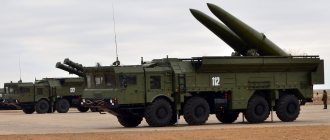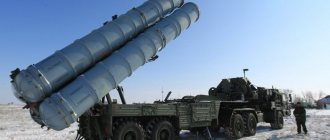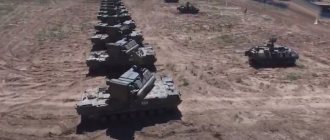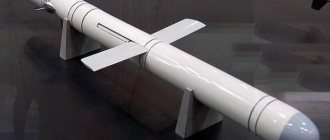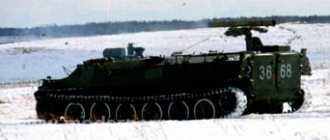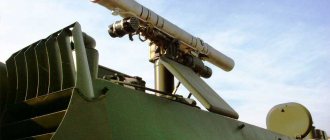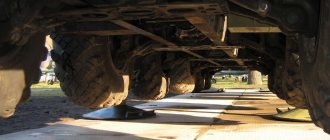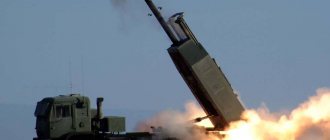For decades, the only weapon capable of hitting important targets behind enemy lines was specially powerful artillery. However, the development of missile weapons in the years after World War II led to the emergence of such a variety as tactical missiles.
The relatively short launch range was much higher than the firing range of artillery, the warhead was more powerful than shells, and the launchers remained mobile. One of the typical and well-known representatives of tactical missiles is Tochka-U, which Russia inherited from the USSR.
Missile system "Tochka-U" - video of live firing
https://youtube.com/watch?v=sFRxqwxRjfY
The development of the Tochka divisional missile system was started by the Resolution of the Council of Ministers of March 4, 1968. The Kolomenskoe Design Bureau of Mechanical Engineering was appointed as the lead executor on the topic, and S.P. was appointed as the chief designer. Invincible. The missile control system was developed at the Central Research Institute of AG. The launcher was designed and mass-produced by the Barricades Production Association in Volgograd. Serial production of missiles was carried out by the Votkinsk Machine-Building Plant. The chassis for the launcher and transport-loading vehicles were manufactured in Bryansk.
The first two launches of Tochka guided missiles were carried out in 1971 during factory flight tests. Serial production of the missile began in 1973, although the complex was officially put into service in 1976. The Tochka complex had a firing range of 15 to 70 km and an average circular deviation of 250 m. In April 1971, the development of the Tochka-R modification began, with a passive homing system for radio-emitting targets (radars, radio stations, etc.). The guidance system provided a target acquisition range at a distance of at least 15 km. It was assumed that the accuracy of Tochka-R's guidance on a continuously operating target did not exceed 45 m, and the affected area was over two hectares. In 1989, the modified 9K79-1 Tochka-U complex was put into service. Its main difference is its long range and shooting accuracy. In the west, the complex received the designation SS-21 “Scarab”.
Composition of the Tochka-U 9K79 (9K79-1) missile system: Missiles:
9M79B with an AA-60 nuclear warhead with a power of 10 kt 9M79B1 with a nuclear warhead of special importance AA-86 9M79B2 with an AA-92 nuclear warhead 9M79F with a high-explosive fragmentation warhead of concentrated action 9N123F (9M79-1F) 9M79K with a cluster warhead 9N123K (9M79-1K) 9M79FR with high-explosive fragmentation warhead and passive radar seeker 9N123F-R (9M79-1FR)
Launchers:
- 9P129 (except for the 9M79F-R missile) (9P129-1)
- 9P129M (9P129-1M)
- 9P129M-1
Transport-loading machine (TZM) 9T218 (9T218-1). Special vehicles:
- Transport vehicles 9T238, 9T222
- Storage machines – special onboard machine type NG2V1 (NG22V1)
Containers:
- 9YA234 for missile unit and missiles
- 9Y236 for the warhead
Airfield storage trolleys:
- 9T127, 9T133 for the missile unit
- 9T114 for warhead
Maintenance and routine maintenance equipment:
- automated control and testing machine AKIM 9V819 (9V819-1) for carrying out
- routine maintenance of missile and warheads (except for special warheads).
- MTO 9V844 maintenance vehicle – for checking PU and AKIM control panel equipment
- The MTO-4OS maintenance machine is designed for repair and maintenance of the base part (four-axle vehicles).
- a set of arsenal equipment 9F370 for carrying out routine maintenance at bases and arsenals.
Communication controls - command and control vehicle R-145BM (R-130, R-111, R-123).
Educational and training aids:
- training missiles 9M79F-UT, 9M79K-UT.
- training combat unit - 9N39-UT, 9N64-UT.
- overall weight model - 9M79-GVM.
- cutaway model of a 9M79 missile unit.
- cutaway model of a high-explosive fragmentation warhead of concentrated action - 9N123F-RM.
- cutaway model of a cluster warhead - 9N123K-RM.
Trainers:
- 9F625 – a comprehensive simulator for training PU calculations.
- 2U43 – simulator of the launcher driver’s control panel.
- 2U420 – operator simulator.
- 2U41 – a simulator for training the correctness of taking readings from the 1G17 gyrocompass.
- 2U413 – 9M79F simulator-rocket, interaction of complex elements.
In addition to the listed equipment, the technical departments are armed with 9T31M1 cranes and 8T311M washing and neutralizing machines and other equipment.
Modifications and upgrades
The result of the work was the adoption of the Tochka-R complex into service in 1983. In principle, it differs from the old system only in the new way of pointing the missile at the target. More precisely, the designers returned to the idea of a radar guidance system.
The new complex can automatically lock onto a target at a distance of 15 kilometers, after which standard control mechanisms inherited from the old Tochka are put into action.
However, the new installation may well use the entire range of missiles that were produced in past years.
But this is not the only thing that characterizes the new Tochka-U installation. The damage radius has also been increased. The new rocket received a solid fuel engine weighing one ton. The flight range then immediately increased to 120 kilometers, which also made it possible to create nuclear variants of projectiles.
Transport-loading vehicle 9T218-1 of the Tochka-U complex
In addition to the 9T238 transport vehicle, the complex also includes the 9T222 transport vehicle. Externally, they are very similar and their transportation capabilities are identical. Both are active road trains – i.e. The semi-trailer axles are driven. The fundamental difference between these units is in the method of transmitting torque from the tractor to the semi-trailer axles - in one case the transmission is hydraulic, and in the other - mechanical. The organizational complex is part of the MSD or TD, as well as in separate teams (2-3 RDN each), in the division – 2-3 starting batteries, in a battery there are 2-3 launchers. . Combat work is carried out on the move by a crew of 3 people in the shortest possible time. Due to the presence in the launcher of a system for topographical reference, aiming, communication equipment, as well as life support equipment when operating in contaminated terrain, the launcher crew can launch missiles from the cockpit. The 9K79 (9K79-1) missile system can be transported by AN-22, IL-76, etc. .d. Missiles, missile parts and warheads can be transported by helicopters such as MI-6, V-12, MI-8.
Further work
All Fakel projects never went beyond drawings and sketches. Around 1966, all the developments were transferred to the Kolomenskoye Design Bureau, and the project was immediately supervised by S.P. Nepobedimy. However, Kolomna engineers completely agreed with the point of view of their colleagues from Fakel: indeed, an inertial guidance system would be optimal. In fairness, it is worth noting that later the project was completely redesigned. In fact, all that remains of it is its name - “Tochka-U”. The installation has been significantly improved, its design has been reduced in cost.
In general, the active stage of work started only in 1968. This time the project was supported by about 120 various scientific and technical enterprises, which created Tochka-U. This approach was dictated by the fact that in the shortest possible time it was necessary to create not only the rocket itself, but also a mechanical chassis, as well as a launch installation and a huge amount of electronic “stuffing”. A huge contribution was made by the Volgograd “Barricades”, who created the launcher from scratch, as well as the Bryansk automobile plant, at whose facilities all the elements of the new chassis were developed and created.
Criticism
Shot test launch of the 3M30 "Bulava" rocket from the full-scale stand SM-E336. The first frame is the starting solid propellant rocket motor/pad is working, the second frame is free flight, the third frame is the 1st stage solid propellant motor is starting, the fourth frame is the 1st stage of the rocket is working.
The Americans believe that in all its features the Bulava is actually one hundred percent identical to their Poseidon-C3 missile, which has already been withdrawn from service as morally obsolete. But this does not correspond to reality at all, because the Poseidon-C3 missile has two stages and the highest firing range of 5600 km (6 MIRVs).
According to some professionals, replacing sea-based liquid missiles with the Bulava will repeatedly reduce the nuclear deterrence potential due to a threefold reduction in the throw weight of the Project 955 submarine with the Bulava.
But, according to the general designer of Topol and Bulava, Yuri Solomonov, a fairly serious reduction in the rocket’s payload is associated with its higher survivability: resistance to the damaging factors of a nuclear explosion and laser weapons, a low active section and its short duration. According to his statement, “Topol-M and Bulava have an active section that is 3-4 times smaller compared to Russian missiles, and 1.5-2 times smaller than South American, French, and Chinese missiles.”
Iraq
Iraq's Shiite government has increasingly come into conflict with other ethnic and religious groups within the country. The ruling elites strive to take control of all institutions of power. This leads to a disruption of the already unstable balance between Shiite, Kurdish and Sunni groups.
Iraqi government forces are fighting the Islamic State. At one time, terrorists managed to include several cities in Iraq into their “caliphate”. Tension also persists in that part of the country where the position of the Kurds is strong, and they are not giving up attempts to create Iraqi Kurdistan.
Experts note that violence in the country is becoming more pronounced. The country is likely to face a new round of civil war.
Combat use
The first combat use of Tochka missile systems occurred in 1994, during the war between the troops of the southern and northern parts of Yemen.
The complexes were actively used during the counter-terrorism operation in the North Caucasus, as well as during the armed conflict in South Ossetia.
It was used by the Ukrainian army in the armed conflict in the east of the country in 2014-2015, in particular during the battles for Saur-Mogila. According to the Chief of the General Staff of the Armed Forces of Ukraine Muzhenko, tactical missile weapons were actively used in the battles for Saur-Mogila: “In July-August 2014 year, due to the inaccessibility of enemy targets for other fire weapons during the battles for Saur-Mogila, 1 RDN 19 RBR carried out tasks for general, and sometimes direct, support of units of the Ukrainian Armed Forces. During the execution of the tasks, up to 20 group and single missile strikes were carried out against concentrations of enemy personnel and equipment, involving from 1 to 4 Tochka launchers.” Cases of the use of Tochka-U in the Donbass were analyzed in detail in the investigation of Andrei Karlov [ unauthorized source?
].
The CAA has been used in Syria since 2013.
Currently used by the Houthis against Saudi coalition forces in Yemen.
Gaza Strip
The Gaza Strip has been on the list of hot spots for a long time. Conflicts between Israel and the Palestinian group Hamas have flared up again and again for decades. The main reason is the reluctance of the parties to listen to each other's arguments.
Thus, Israel launched a military operation in order to destroy the infrastructure of underground tunnels and warehouses with stocks of Palestinian weapons in order to deprive terrorists of the opportunity to attack Israeli territory. Hamas demands the removal of the economic blockade of the Gaza Strip and the release of prisoners.
The immediate cause of the fighting that has now unfolded in the Gaza Strip was the death of three Israeli teenagers, and in response to this, the murder of a Palestinian. And on July 17, 2014, the next military action began: tanks drove in, missiles flew.
Several times during this time the parties were planning to conclude a truce, but all attempts to reach an agreement led nowhere. Shells are still exploding, people are dying, and journalists in hot spots are taking such pictures that it’s scary to watch...
Creation Story
The decision in favor of developing the Bulava missile was made in 1998 by Vladimir Kuroyedov, newly appointed to the post of Commander-in-Chief of the Russian Navy, after three unsuccessful tests of the Bark strategic weapon complex, which was more than 70% complete. As a result, the Security Council of the Russian Federation abandoned the development of the Miass Design Bureau named after. Makeev (developer of all Russian submarine-launched ballistic missiles - SLBMs, except R-31) and transferred the development of the latest naval strategic missile Bulava to the Metropolitan Institute of Thermal Engineering.
The arguments in favor of such a decision were the desire to unify sea and land solid fuel missiles. Opponents of this decision pointed to the incomprehensible advantages of unification, MIT’s lack of experience in creating sea-based missiles, and the need to remake the Yuri Dolgoruky nuclear submarine, which has been under construction since 1994 at the Sevmash Severodvinsk machine-building enterprise and was originally designed for the Bark.
The creation of Bulava missiles will be deployed at the Federal State Unitary Enterprise Votkinsk Plant, where Topol-M missiles are already being produced. According to the developers, the structural elements of both missiles are highly unified.
Video: Short documentary Mace Strike
After successful tests of the Bulava, on June 29, 2007, a decision was made to mass produce more mature components and parts of the rocket.
Afghanistan
The Afghan government, forced to spend time and energy fighting between warring factions, after the withdrawal of NATO troops in 2014, is unable to maintain peace in the country and the safety of its citizens.
In 2012, relations between the United States and Afghanistan deteriorated sharply. The culmination of events was the mass execution of villagers in Kandahar province, which was carried out by an American soldier. Among the 17 victims of the massacre there were nine children.
These events led to widespread unrest and provoked a series of military actions by the Afghan military.
Experts believe that in the coming years the country's ruling elite will continue to be torn apart by acute contradictions. And the Taliban insurgency will certainly take advantage of these differences to achieve its extremist goals.
Notes
Comments
- For mounting the rocket on the launcher guide in the stowed position
- On the rear yoke there is additionally a clamp for attaching the rocket to the SPU and TZM (from longitudinal movement) and holding the rocket when lifting the guide
- The derailment sensor turns on the steering drive of the rocket when it leaves the launcher guide. The moment the sensor is triggered is the beginning of the flight program.
- Cotton fabric impregnated with a special non-flammable compound is used as armor.
Sources
- ↑ Trembach E.I., Esin K.P., Ryabets A.F., Belikov B.N.
“Titan” on the Volga. From artillery to space launches / Under the general editorship. V. A. Shurygina. - Volgograd: Stanitsa-2, 2000. - P. 53-56. — 1000 copies. — ISBN 5-93567-014-3. - Lensky A. G., Tsybin M. M.
Soviet ground forces in the last year of the USSR. Directory. - St. Petersburg: V&K, 2001. - P. 266. - 294 p. — ISBN 5-93414-063-9. - ↑
- Volume 1.5 MB.
- DIMMI.
. Domestic military equipment (after 1945) (05/11/2010 00:38:00). Retrieved June 14, 2010. - The Military Balance 2022. - P. 183.
- The Military Balance 2022, p.184
- The Military Balance 2022, p189
- The Military Balance 2022, p.93
- The Military Balance 2022. - P. 371.
- The Military Balance 2022, p.192
- The Military Balance 2022. - P. 276.
- The Military Balance 2022, p.197
- The Military Balance 2022, p.369
- The Military Balance 2022, p.197
- ↑ Valetsky O. V., Lyamin Yu. Yu.
Distribution of rocket technologies in the third world. - Pushkino: Center for Strategic Conjuncture, 2013. - P. 5. - 60 p. — ISBN 978–5–906233–34–9. - . Peter and Mazepa. Retrieved April 16, 2016.
- . Lost Armour. Retrieved May 21, 2022.
Tests
According to reports in the Rossiyskaya Gazeta, on May 24, 2004, an explosion occurred at the Votkinsk Machine-Building Plant (it is part of the MIT corporation) during testing of a solid fuel motor.
Votkinsk plant, which produces the Bulava rocket on Google map. The address of their website is vzavod.ru, there are also contacts.
Video: 20th Launch of the Mace
On September 23, 2004, from the modernized nuclear submarine TK-208 “Dmitry Donskoy” of Project 941 Razum (the submarine is based at the Sevmashpredpriyatie in Severodvinsk), a successful “throw” launch of a weight-dimensional mock-up of the “Bulava” missile was carried out from an underwater state. The test was carried out to test its ability to be used from submarines. In the press, this launch of the Bulava is considered to be the first in a row, although only the launch of a weight and size mock-up of the rocket was carried out.
- The first (2nd) test launch of the Bulava was successfully carried out on September 27, 2005 at 17:20 Moscow time. The missile, launched from the waters of the Snow-White Sea from the nuclear submarine "Dmitry Donskoy" (Project 941 of the "Typhoon" class, side number TK-208) from the surface at the Kura test site in Kamchatka, covered more than 5.5 thousand km in approximately 14 minutes, after which The missile warheads successfully hit those created for their target at the test site.
- The 2nd (3rd) test launch of Bulava was carried out on December 21, 2005 at 08:19 Moscow time, also from the nuclear submarine Dmitry Donskoy. The launch was carried out from an underwater position at the Kura training ground, the missile successfully hit the target.
- The 3rd (fourth) test launch from the nuclear submarine Dmitry Donskoy on September 7, 2006 ended in failure. The ICBM was launched from an underwater position towards the battlefield in Kamchatka. After floating around for a couple of minutes after launch, the Bulava rocket fell into the sea.
- The fourth (5th) test launch of the missile from the nuclear submarine Dmitry Donskoy, which took place on October 25, 2006, also ended unsuccessfully. After several minutes of flight, the Bulava deviated from its course and self-destructed, falling into the Snow-White Sea.
- The 5th (6th) test launch of the Bulava missile was carried out on December 24, 2006 from the nuclear submarine Dmitry Donskoy (surface position) and again ended unsuccessfully. The failure of the rocket's third stage motor led to its self-destruction 3-4 minutes into the flight.
- The 6th (seventh) test launch took place on June 28, 2007. The launch was carried out in the Snow-White Sea from the nuclear submarine "Dmitry Donskoy" from an underwater position and ended partly successfully - the 3rd warhead of the Bulava did not reach the target.
- The seventh (eighth) launch took place on November 11, 2007 - it became the fifth bad launch of the Bulava. There is no official information about the launch. To complete the tests, another 10..14 launches may be required.
- Eighth launch. On September 18, 2008, a Russian strategic submarine missile cruiser launched a Bulava missile from an underwater position at 18:45 Moscow time on Thursday. At 19:05, the training units reached their target in the area of the battlefield of the Kura training ground. “Telemetric information about the launch and flight of the Bulava missile is currently being processed, but at this moment we can conclude that the launch and flight of the missile took place as usual,” said a representative of the Russian Ministry of Defense. (part of the information from the website interfax.ru) According to the latest information, this launch is also considered bad, the Kommersant newspaper writes, citing a source in the Russian Ministry of Defense. According to the publication’s interlocutor, the tests were successful until the final step. “The active section of the missile’s movement line passed without failures, hit the area, the warhead separated normally, but the stage for disengaging the warheads was unable to ensure their separation,” he told the newspaper. Thus, as he explained, in combat conditions the warheads of the Bulava missiles would not have worked due to the peculiarities of the Bulava device. The publication was unable to obtain a comment from the Commander-in-Chief of the Russian Navy Igor Dygalo regarding the information received.
The State Research Center "Design Bureau named after Makeev" proposed to resume development in 2008 on its own base.
In 2008, JSC PA Sevmash carried out repairs and completed modernization under Project 941 Reason of the nuclear submarine Dmitry Donskoy used for testing.
The rocket and its characteristics
Of course, the main “actor” of the system is the 9M79 single-stage solid-fuel rocket.
Its dimensions are 640 x 65 cm (length, diameter). Of the two tons of total mass, approximately 500 kg is the warhead. The rocket is accelerated by a single-mode solid fuel engine, which burns about 800 kg of fuel during the flight (up to 28 seconds). Flight control is carried out by an inertial guidance system, the basis of which is a 9B64 gyroscope and a 9B65 computing device. Tochka-U does not provide for the separation of the warhead at the end of the flight. The missile dives onto the target at almost a right angle, which guarantees high accuracy.
Development prospects
The UN tried to put an end to the development of thermobaric ammunition, looking everywhere for “inhumane weapons that cause excessive suffering” (although in this reading only those that kill instantly and immediately should be considered humane). However, as already noted, its resolutions were not a ban.
A promising direction seems to be the use of so-called “reactive materials” in thermobaric ammunition - substances that are not explosive in themselves, but in which a high-speed impact (for example) can trigger an intense reaction.
The rapid combustion of fragments of reactive materials in air significantly increases the high-explosive effect of projectiles, and large fragments, igniting upon penetration, create a thermobaric pulse in the space outside the barrier. Today, such weapons exist in the form of prototypes.
Hot spots of Central Asia
Tension in the region is created by Afghanistan, where wars have not subsided for many decades, as well as Uzbekistan, Tajikistan and Kyrgyzstan, which have become involved in territorial disputes with each other. Another reason for constant conflicts in the region is the main drug trafficking in the Eastern Hemisphere. Because of him, local criminal gangs constantly clash.
It seemed that after the Americans removed their military from Afghanistan, calm had finally come to the country. However, it did not last long. After the presidential elections, a lot of dissatisfied people appeared who refused to recognize the vote as legitimate. Taking advantage of the situation in the country, the terrorist organization Taliban began to capture the capital of Afghanistan.
In the winter of 2014, Tajikistan and Kyrgyzstan became involved in territorial disputes, which was accompanied by military operations in the border areas. Tajikistan stated that Kyrgyzstan had violated existing borders. In turn, the Kyrgyz government accused them of the same thing. Since the collapse of the USSR, conflicts have periodically arisen between these countries over the existing designation of borders, but there is still no clear division. Uzbekistan also intervened in the dispute, presenting its own claims. The question is still the same: the country’s authorities do not agree with the borders that were formed after the collapse of the USSR. The states have already tried more than once to somehow resolve the situation, but they have not come to an agreement or a concrete solution to the issue. At the moment, the atmosphere in the region is extremely tense and could result in military action at any moment.
Operators
Map of operators of the Tochka shopping and entertainment complex In service Withdrawn from service
"Tochka-U" at the parade in Baku, June 26, 2011
- Azerbaijan - 4 9M79 units as of 2022
- Armenia - 4 units as of 2022
- Belarus - 36 units as of 2022
- Bulgaria - in service, as of 2022
- Yemen - some, as of 2022
- Kazakhstan - 12 units as of 2022
- DPRK - some KN-02 Toksa, as of 2018
- Russia - 24 Tochka-U units as of 2022
- Syria - some, as of 2022
- Ukraine - 90 units as of 2022
Withdrawn from service
- USSR - As of 1991, the USSR had 250-300 launchers Tochka
- Poland
- Uzbekistan - 5 units as of 2010
- Czechoslovakia
Kenya
Conditions for conflict continue to exist in the country. Kenya is characterized by high youth unemployment, appalling poverty and social inequality. Security reforms that had begun have been suspended. Experts are most concerned about the increasing ethnic disunity of the population.
The threat from militant groups that have settled in Somalia continues. The response to their attacks may be a militant reaction from the local Muslim community.
Combat use
Cruise missiles of the "Caliber" series were often used during the Russian military operation in Syria. In addition, this is their first combat use.
| date | Rocket | Quantity | Carrier | Target |
| 07.10.2015 | 3M14T | 26 | RC "Dagestan" MRK "Grad Sviyazhsk" MRK "Uglich" MRK "Veliky Ustyug" | 11 targets in Syria at a distance of over 1500 km |
| 20.11.2015 | 3M14T | 18 | ships of the Caspian flotilla | For 7 targets, terrorist positions in the Syrian provinces of Raqqa, Idlib and Aleppo. |
| 08.12.2015 | 3M14K | 4 | DEPL "Rostov-on-Don" | Strike on two major Islamic State terrorist points in Raqqa in Syria |
| 19.08.2016 | 3M14T | 3 | MRK "Zeleny Dol" MRK "Serpukhov" | For the purposes of the terrorist group Jabhat al-Nusra in Syria. |
| 15.11.2016 | 3M14T | 3 | frigate "Admiral Grigorovich" | On terrorists in the Syrian provinces of Idlib and Homs. |
| 31.05.2017 | 3M14T/K | 4 | TFR "Admiral Essen" diesel-electric submarine "Krasnodar" | According to the positions of militants located east of Palmyra. |
| 23.06.2017 | 3M14T/K | 6 | frigate "Admiral Essen" frigate "Admiral Grigorovich" diesel-electric submarine "Krasnodar" | Strike against Islamic State (IS) targets in Syria. |
| 05.09.2017 | 3M14T | 6 | frigate "Admiral Essen" | On ISIS targets in Syria in the Deir ez-Zor area. |
| 14.09.2017 | 3M14K | 7 | Diesel submarine "Veliky Novgorod" Diesel submarine "Kolpino" | On the objects of the ISIS group in Syria. The strike range ranged from 500 to 670 km. |
| 22.09.2017 | 3M14K | 3 | DEPL "Veliky Novgorod" | At the targets of the Jabhat al-Nusra terrorist group in Idlib province. The range to the targets was about 300 km. |
| 05.10.2017 | 3M14K | 10 | Diesel submarine "Veliky Novgorod" Diesel submarine "Kolpino" | Targeting terrorists of the ISIS group banned in Russia in Syria with Caliber cruise missiles. |
| 31.10.2017 | 3M14K | 3 | DEPL "Veliky Novgorod" | At ISIS militant targets in the province of Deir ez-Zor in the Al-Bukemal region. |
| 03.11.2017 | 3M14K | 6 | Diesel submarine "Kolpino" | At ISIS militant targets in the province of Deir ez-Zor in the Al-Bukemal region. |
Syria
The military conflict in Syria flared up after the authorities brutally suppressed opposition demonstrations that broke out under the auspices of the Arab Spring.
Clashes between the government army under the command of Bashar al-Assad and the coalition of Syrian armed forces led to a real war. It affected almost the entire country: about 1,500 groups (al-Nusra Front, ISIS and others) joined the military action, more than 100 thousand citizens took up arms. Radical Islamists have become the most powerful and dangerous. Hot spots are scattered throughout the country today. After all, Syria is under the control of a variety of terrorist gangs. Most of the country is currently controlled by government forces. The north of the state is completely captured by ISIS fighters. Although in some places the Kurds are still trying to win back territory. Not far from the capital, militants from an organized group called the Islamic Front have become more active. And in the city of Aleppo, there are skirmishes between Assad’s military forces and the moderate opposition.
Carriers
The following ships of foreign and Russian navies are equipped with missiles of the Kalibr-NK and Kalibr-PL series
- Project 22350 frigates;
- Project 11356 frigates;
- Talwar-class frigates;
- Shivalik-class frigates;
- Project 20385 corvettes;
- Project 11661 missile ships (depending on modification);
- Small rocket ships of project 21631;
- Small rocket ships of project 22800;
- Project 22160 patrol ships (depending on modification);
- Project 955 Borei submarines (as secondary weapons);
- Project 885 Yasen submarines;
- Submarines of project 636 “Varshavyanka”;
- Project 677 submarines.
According to Viktor Chirkov, the former Commander-in-Chief of the Navy, in the near future, most of the Soviet-built Russian Navy ships, including the Project 1144 cruiser, Project 956 destroyers and Project 1155 anti-submarine ships, after modernization, will receive missile systems with Onyx and Caliber missiles.
In recent years, software and loading facilities have been created, delivered or put into operation for the 3K14, 3M55, 9K, 3K96 missile systems and for the small-sized torpedo system “Packet”, located on modern ships of the Russian Navy. The family of vertical launchers of surface ships of the 3S14 type ensures the placement on the NK of projects 1161K, 21631, 11356M of products of the 3K14 complex, and on the NK of projects 22350, 20385, 11442M, in addition, also of products of the 3M55 and 9K OKB complexes. KBSM is the creator and supplier of mass-produced transport and launch cups made of composite materials with a destructible lid for complex 9K and 3K14 products. To load the products of the specified sets into the NK control unit, complexes of loading equipment of the SM-456 type have been developed.
It is unlikely that the inapplicability of the Onyx anti-ship missile system in some UKKS is somehow related to the size of the ammunition, since 3M14 and 3M55 have approximately the same length (according to some information, about 8.1 and 8.6 meters). Most likely, the 3S14 combat kit is artificially reduced due to the control system. This looks especially ridiculous with 20385 (with Onyx) and 11356 (without Onyx).
Operators
- Russia.
- China.
- India.
South Sudan
The country is divided into two opposing tribal unions - the Nuer and the Dinka. The Nuer are the predominant population of the state, including the current president. The Dinka are the second largest people in South Sudan.
The conflict erupted after the President of Sudan announced to the public that his assistant, the Vice President, was trying to provoke a coup in the country. Immediately after his speech, mass unrest, protests and numerous arrests began in the country. Complete devastation and disorganization resulted in a real military conflict.
Today, the oil-producing areas of the country are hot spots. They are under the rule of rebels led by a disgraced vice president. This had a negative impact on the economic component of Sudan. The civilian population of the country also suffered greatly: more than ten thousand victims, about seven hundred thousand were forced to become refugees. In order to somehow resolve this conflict, the UN sent its peacekeeping contingent to South Sudan, which was supposed to serve as protection for the civilian population.
In the spring of 2014, militant alliances tried to come to some kind of compromise. However, the rebel leader openly admitted that he had long ago lost power over the rebels. In addition, peace negotiations were prevented by Ugandan troops acting on the side of the Sudanese president.
Tactical and technical characteristics of the Tochka-U complex
Firing range…………..minimum: 15 (15) km; maximum: 70 (120) km Rocket speed………………300-500 m/s Launch mass………………2010 kg Engine thrust………………9788 kgf Operating time………………18–28 s Flight time to the maximum range…………136 s Warheads (warheads)………weighing up to 482 kg, conventional, nuclear and chemical equipment, according to the nomenclature Time to prepare for launch……..from readiness No. 1: 2 min.; from march: 16 min. Weight of launcher (with missile and crew)……………18145 kg. Maximum speed of movement of launcher with missile…….on highway: 60 km/h; on dirt roads: 40 km/h; off-road: 15 km/h; afloat: 8 km/h Fuel range of combat vehicles (with a full load)…………650 km Technical life of combat vehicles………………15000 km Crew………………4 people
Eastern Ukraine
Part of the former USSR space has also turned into a “hot spot” on the planet. The cause of the protracted conflict was the desire of certain territories of Ukraine for independence. In this cauldron, which has spread to Lugansk and Donetsk, serious passions are boiling: interethnic conflicts, acts of terror, and murders of the leaders of the rebel side are mixed in with the threat of a full-scale civil war. The number of victims of the military confrontation is growing every day.
The situation in Donbass remains one of the central topics in news feeds around the world. Kyiv and the West in every possible way accuse Russia of contributing to the expansion and deepening of the conflict by helping the self-proclaimed republics of South-East Ukraine. The Russian authorities consistently deny these accusations and continue to call for a diplomatic solution to the issue.
The missile is equipped with the following types of warheads:
AA-60 - nuclear with a yield of 10 to 100 kt, AA-86 - nuclear of special importance, AA-92 - nuclear 9N123F - high-explosive fragmentation concentrated action, 9N123K - cassette, 9N123F-R - high-explosive fragmentation with a passive radar seeker.
The warhead of the rocket does not separate in flight. The docking of the missile and warhead is carried out by 6 hinged bolts with self-locking nuts along a ring connection, the electrical connection of the warhead with the missile part is carried out by cable through the Ш45 connector. The presence of replaceable warheads expands the range of application of the complex and expands its effectiveness. Missiles in conventional equipment can be stored in their final assembled form for 10 years. There is no need to carry out assembly work with missiles in the army. When carrying out routine maintenance, there is no need to remove instruments from the rocket body. When calculating the flight mission when pointing the “Point” at a target, digital maps of the area are used, obtained from the results of space or aerial photography of enemy territory.
China and countries of the region
Today the Paracel Islands are the hot spots of the planet. The conflict began with the fact that the Chinese suspended the development of oil wells near the archipelago. This did not please Vietnam and the Philippines, which sent their troops to Hanoi. To show the Chinese their attitude to the current situation, the military of both countries played an exhibition football match on the territory of the Spratly archipelago. This angered Beijing: Chinese warships appeared near the disputed islands. There were no military actions on the part of Beijing. However, Vietnam claims that Chinese-flagged warships have already sunk more than one fishing boat. Mutual reproaches and accusations can at any moment lead to missiles flying.
